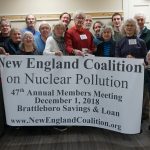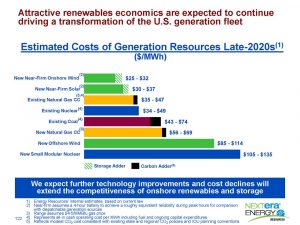OUR MISSION: NEW ENGLAND COALITION ADVOCATES FOR A SAFE, NUCLEAR FREE, ENERGY FUTURE
NEC investigates the safety, suitability, and environmental effects of nuclear power plants; we participate in government hearings; and we inform the public and government agencies of the hazards and risks of nuclear power.
_______________________________________________
It Is More Important Than Ever Before to Oppose Nuclear Power
George Harvey
A look at the news shows that environmentalists are increasingly favoring nuclear power as a way to address climate change. The reason for this is that they fear the consequences of climate change more than the possibilities of a nuclear accident, and they fear the buildup of atmospheric carbon dioxide more than the problem of what to do with nuclear waste.
The arguments against nuclear power have been around as long as nuclear power has, but they have not stopped nuclear plants from being built. The most effective anti-nuclear arguments have been derived from nuclear events. Several of those events are well known: Chernobyl, Three Mile Island, three meltdowns at Fukushima Daichi. There were others, not as well known. But it was the fact that we had views of real meltdowns in the past that made us aware of the problems of nulear waste.
Now, over twelve years since the last big meltdowns, activists are losing sight of them again, as they increasingly fear climate change. They see nuclear power as a way to address the worst of global warming. Unfortunately for them, and us, nuclear power is a gigantic distraction that can only slow down the efforts to deal with the climate.
The cost of nuclear power is very high compared to near-firm solar power and near-firm wind. The term “near-firm” first came to our attention when it was introduced and used late last year by NextEra Energy. NextEra is, by some metrics, the largest electric utility in the United States. It owns seven nuclear reactors. And yet, as wehave mentioned before, the company’s ten-year investment projections do not include any generating capacity, aside from solar and windpower, both to be backed up by energy storage to the point of being “near-firm,” meaning that its reliability is comparable to that of nuclear plants.
The reason for NextEra’s position is that it projects nuclear power as costing three to four times as much as near-firm solar or wind. They are not alone in this. Wood Mackenzie also projects the cost of nuclear power at four times that of renewables.
We should add that nuclear plants have historically taken a long time to build, three times or more as much as solar and wind, and we don’t even have any small modular reactors in this country, let alone the factories that have to be built to make them. It could take a decade to start really moving on SMRs, and that is a decade too long to address climate change.
Believing that it is important to address climate change as quickly as possible, we are led to the belief that it is vital that we not waste time or money on nuclear reactors of any kind. Both are badly needed elsewhere, in ways that are effective.
To deal as effectively with climate change as possible, it is vital that we avoid wasting time and money on nuclear power.
——————-
WTSA News For Your Monday, December 12th:
The Vermont Nuclear Regulatory Commission
Decommissioning Citizens Advisory Panel meets tonight at 6. In
addition to receiving updates from NorthStar and Vermont State
Agencies regarding recent Vermont Yankee decommissioning activities,
the Panel will consider endorsing recent International Brotherhood of
Electrical Worker comments filed in response to the Nuclear
Regulatory Commission’s proposed rules governing nuclear power
plant decommissioning. The Panel will also review and potentially
approve its 2022 Annual Report to the Vermont Legislature and
Governor. The meeting will be conducted solely as a webcast and
teleconference via Zoom.
_______________________________________________
From our friends at Beyond Nuclear:
and
Lessons from Hiroshima and Nuclear Power:
and
Why Should We Pay Extra for Nuclear Power?
Commentary by George Harvey
There were a couple of interesting developments last month in regards to electric power. One was that NextEra Energy issued its Investor Conference Report 2022 to its stockholders. Another was a paper from Stanford University, “Low-cost solutions to global warming, air pollution, and energy insecurity for 145 countries,” (LCS study) by Mark Z. Jacobson et al. Looking into them is rather interesting.
The first of these makes very clear that in the opinions of the people running NextEra Energy, combustion generating sources and nuclear power are getting too expensive. Furthermore, their opinion is that the most expensive of these, at least in the late 2020s, will be small modular nuclear reactors (SMRs). The accompanying chart, from their investor report, shows this.
A couple of things stand out because of their explicit statements in the chart. One is, “Attractive renewables economics are expected to continue driving a transformation of the U.S. generation fleet.” The other says, “We expect further technology improvements and cost declines will extend the competitiveness of onshore renewables and storage.
We should make clear, just in case anyone doesn’t know, that NextEra is hardly anti-nuclear. While it is already the biggest investor in renewable energy in the U.S., it does own seven nuclear reactors, including the one at Seabrook.
One thing to make note of in the chart is that the term “near-firm,” applied to wind and solar power. It means that those power sources are backed up by a four-hour battery, which NextEra regards as sufficient to make the renewable power sources roughly equivalent to dispatchable sources during peak hours. Another thing is that the storage adder is seen to arise costs of solar and windpower by about 0.5¢/kWh. This is represented in the chart by the shaded areias on the bars for solar and windpower.
Another thing to note is that in this chart, electricity from new, near-firm solar and wind plants is a good deal less expensive than electricity from existing nuclear plants. Let’s state this clearly: We are paying extra for electricity from nuclear plants, even after they have been paid down, and even though the sun can shine and the wind can blow almost all the time, because of really cheap battery storage. Put another way, it would be cheaper to close the nuclear plants and replace them with new renewable facilities.
When we compare near-firm wind and solar in this chart to SMRs, the advantage of renewable energy is even more impressive. NextEra clearly expects SMRs to generate electricity that costs anywhere from three to five times as much as the near-firm renewables.
Aside from the fact that it is not possible to do everything all at once, there really is no excuse for this. Near-firm renewables may not be perfect, but we can be certain that SMRs will not be perfect either, and we don’t know what types of failure they will experience. It is true that some SMRs are designed to follow changes in demand, but the changes will take time and that makes them very inferior to near-firm renewables, which can change within less than the time of a single cycle of AC power. We should note that even if SMRs really cannot melt down (a premise we should not accept on its face value) they produce a lot of waste, reportedly much more than existing plants, and that waste is a serious problem.
Our conclusion should be that SMRs are very inferior to near-firm renewables in just about every respect.
We should turn to the LCS study. As an academic project, it is based on existing data, modeling, and computations. To give an idea of what that means, we might list some of the steps taken for one portion of the study. It breaks the world into 28 regions, and for each region models the weather that can be expected over a three year period starting in 2050. This is done for different scenarios for generating and using electricity. Energy usage for each region is recalculate for intervals of 30 seconds for the entire three years. That is a lot of computing.
The LCS study does show an analysis based on business-as-usual. But for the renewables section of the study, it does not examine the use of nuclear energy for several reasons. One is that nuclear power produces waste that will be toxic for the foreseeable future and then some. Another is that it is inherently dangers in multiple ways. But of interest here, nuclear power is not built into the energy mix for renewables partly because it is so expensive that it gets in the way of implementing wind, water, and solar power, slowing down our transition away from fossil fuels.
So the bottom line is a question: Why should we pay extra for nuclear energy?

To the extent possible under law, George Harvey has waived all copyright and related or neighboring rights to Why Should We Pay Extra for Nuclear Power?. This work is published from: United States.
◊ ◊ ◊
Thanks to all who joined our 2022 ANNUAL MTG
NEXT UP:
Raymond Shadis CommentaryOne Chance. That’s all we have to get the Vermont Yankee cleanup right.The life and history of the Vermont Yankee site run deeper than the foundations of the former nuclear power plant. The legacy of radioactive contamination, being permanent and wholly undeserved, should be minimized.Raymond Shadis served as technical advisor to the New England Coalition from 1997 to 2019. Read the full article at Beyond Nuclear. +++++++++++++++++++++++++++++++++++++++++++++++++++++++++++++++++++++++++++++++++++++++++++++++++ The New England Coalition has been the people’s advocate for safe energy since 1971. The Coalition was founded by several groups of citizens and scientists concerned about the nation’s growing civilian nuclear power program. Our mission has not changed: we investigate the safety, suitability, and environmental effects of nuclear power plants; we participate in government hearings; and we inform the public and government agencies of the hazards and risks of nuclear power. A combination of the NEC’s network of technical advisors, engineers, lawyers, students, activists and citizens, and the many years of experience and document collection, has earned the Coalition the respect of industry, government and citizens’ groups. They are currently involved in issues about the decommissioning of Vermont Yankee. New England Coalition 802-257-0336 |
DONATE

___________________________________________________________________________________________
PLEASE DONATE ONLINE NOW OR BY MAILING A CHECK TO “NEC” PO Box 545, Brattleboro, VT 05302.
Gifts of appreciated stock or securities are also accepted. Please call Lorie Cartwright at 802-257-0336 for our broker information.
NEC is a 501(c)(3) non-profit organization. YOUR GIFT IS TAX-DEDUCTIBLE
HELP NEC STAND UP TO THE BULLY!
THIS IS A PROTRACTED BATTLE
PLEASE DONATE NOW
Please make your check payable to: New England Coalition, PO Box 545, Brattleboro, VT 05302-0545
Support NEC with a sustaining monthly automatic payment.

